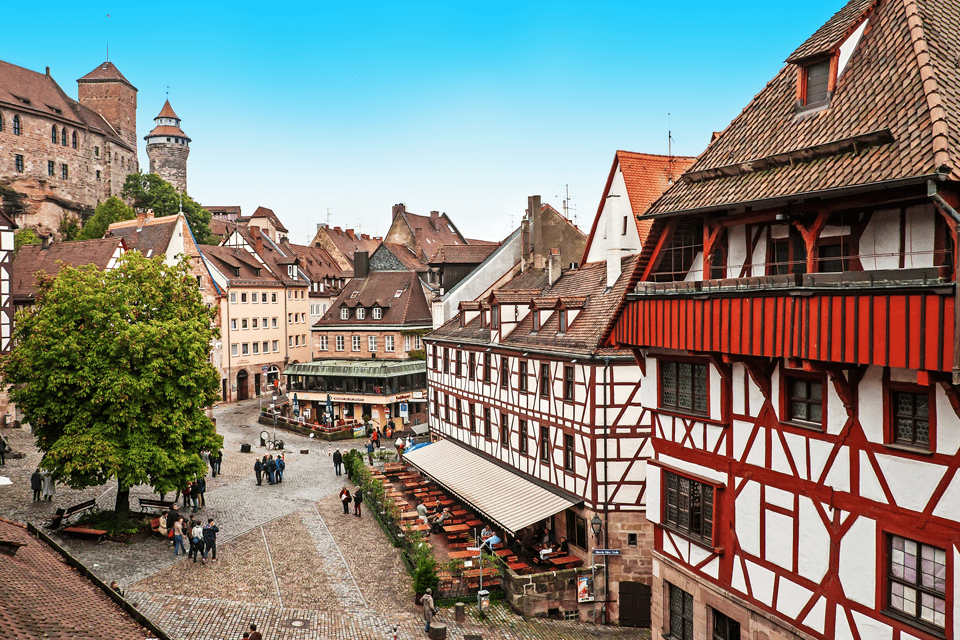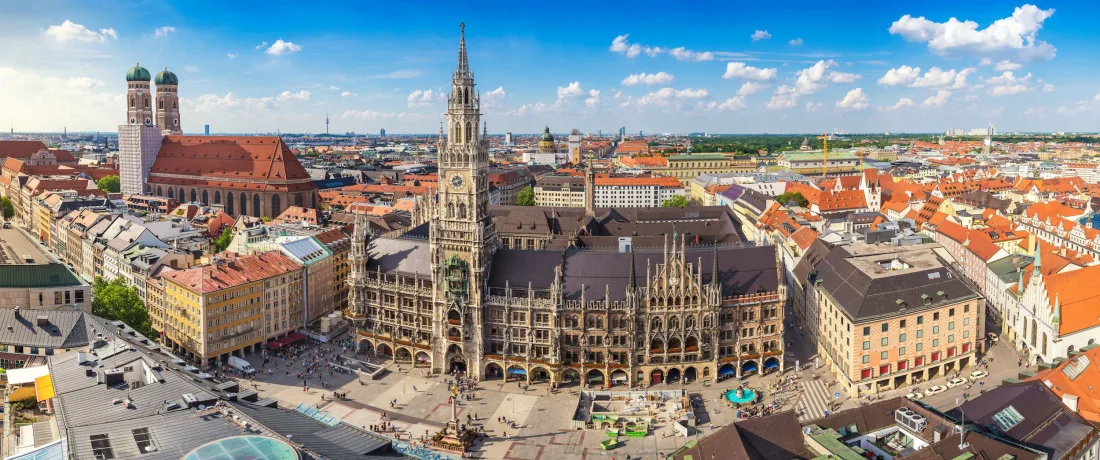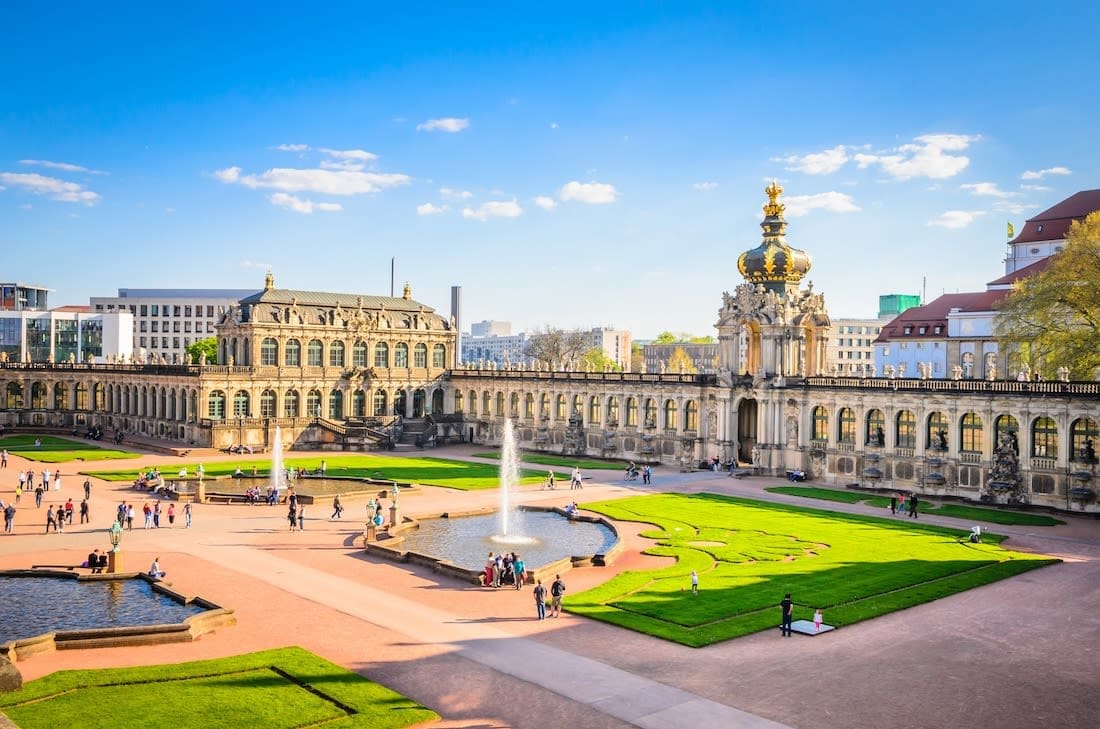Are you dreaming of Germany? Castles, incredible hiking, traditional beer halls, and charming medieval town squares await you! But planning a vacation to Germany for the first time can be a bit overwhelming and it can be difficult to know where to start. Don’t worry, we are here to help you! From the enchanting Bavarian Alps to vibrant cities like Berlin and Munich, Germany has 51 UNESCO World Heritage Sites to explore. Are you struggling to decide between historic castles or museums? Unsure about navigating through Germany, or what is the best time to visit? This guide is your go-to resource to plan a trip to Germany seamlessly. With this, you can turn your dream of exploring Germany into reality with ease and confidence.
When is the best time to visit Germany?
Now, when you are traveling to Germany for the first time, the first question that may arise in your mind is when is the best time to visit Germany? Below you’ll find detailed information on every season so that you can plan your trip accordingly:
Summer (June to August)

The summer season in Germany is the peak tourist season. The hot temperatures make it the perfect time to explore the country’s picturesque lakes and majestic mountains. People usually flock to the beer gardens or to the lakes to swim. Whether you are hiking in the Bavarian Alps or relaxing by Lake Chiemsee, there are countless reasons why summer is the best time to explore Germany. But if you are planning your summer German vacation, book your accommodation and transportation well in advance.
Shoulder Season (Late Spring or Early Autumn)
If you are looking for Goldilocks weather, not too hot, and not too cold, then you can consider the late spring months (May to June) and early autumn months (September to October). May and June have very long days, making it a perfect time for sightseeing as the daylight stretches late into the evening. If you want to experience the high Bavarian Alps, September to early October are less crowded than the summer months and most of the peaks are still free of snow, meaning it’s ideal for hiking. It is also a great time to explore sightseeing and Germany’s cultural treasures.
Munich during Oktoberfest
Are you thinking of visiting Munich during Oktoberfest? It’s an incredible start for a first trip to Germany, as you quaff beer in giant, festively-decorated tents, surrounded by locals dressed in traditional dirndls and lederhosen. But you must prepare well in advance. Oktoberfest, which runs from late September to early October, attracts lots of travelers to Munich. So, if you want to explore Munich and don’t want to attend Oktoberfest, then it’s advisable to avoid this period. If you do want to see this spectacle, you should book your accommodations and flight tickets 9+ months before.
Winter Season (Late November to February)
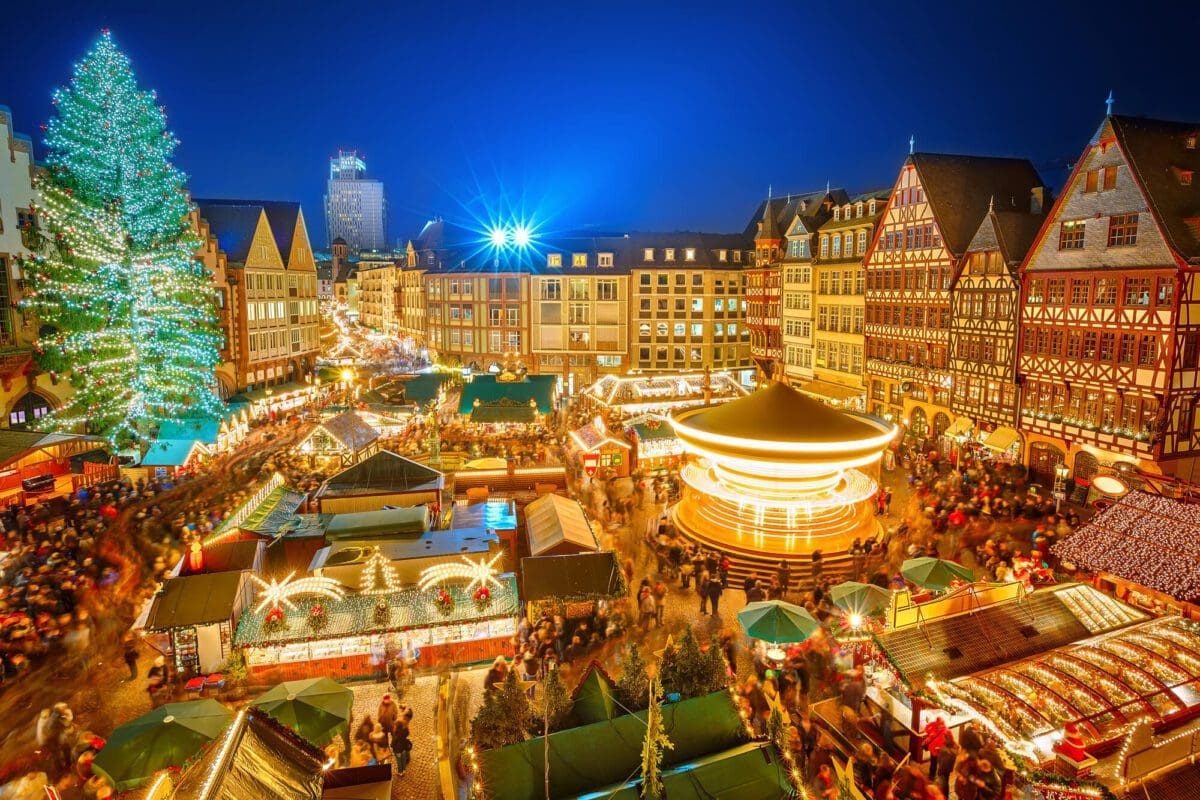
Winter in regions such as Bavaria and the Black Forest transforms landscapes into winter wonderlands, where the temperature sometimes drops as low as 15 degrees Fahrenheit (-10C). During November and December, Germany is famous for its holiday spirit and Christmas Markets which transform traditional town squares into enchanting winter wonderlands filled with twinkling lights, festive decorations, and a warm, inviting atmosphere perfect for celebrating the season. They occur all over the country, but some of the must-see markets include Munich, Nuremberg, and Dresden. Moreover, the ski resorts in the Alps and Black Forest attract winter sports enthusiasts to its snowy slopes. A final tip is to visit Rothenburg ob der Tauber, which is a small town on Bavaria’s Romantic Road. In the winter season, it looks like it came straight out of a holiday storybook and the whole town goes “all-out” on Christmas.
Which Destinations to Choose When Planning a Vacation to Germany
1. Berlin

The first destination you can choose when you are traveling to Germany for the first time is Berlin. Berlin is the capital and heart of modern Germany. The city is famous not only for its techno culture but also for being a melting pot of eras and empires perfect for history lovers. You can discover iconic landmarks like the Brandenburg Gate. Originally built to celebrate victory in war, it became a symbol of division during the Cold War and now represents unity and peace. Nearby you can walk up the glass dome of the Reichstag building, looking down at the lawmakers of the German parliament below, while enjoying epic views of the city around you. You can also visit the Berlin Wall and Checkpoint Charlie to learn more about Germany’s Cold War past. Next, go to Museum Island, a UNESCO World Heritage Site home to 5 world-class museums nestled amidst the River Spree.
2. Munich
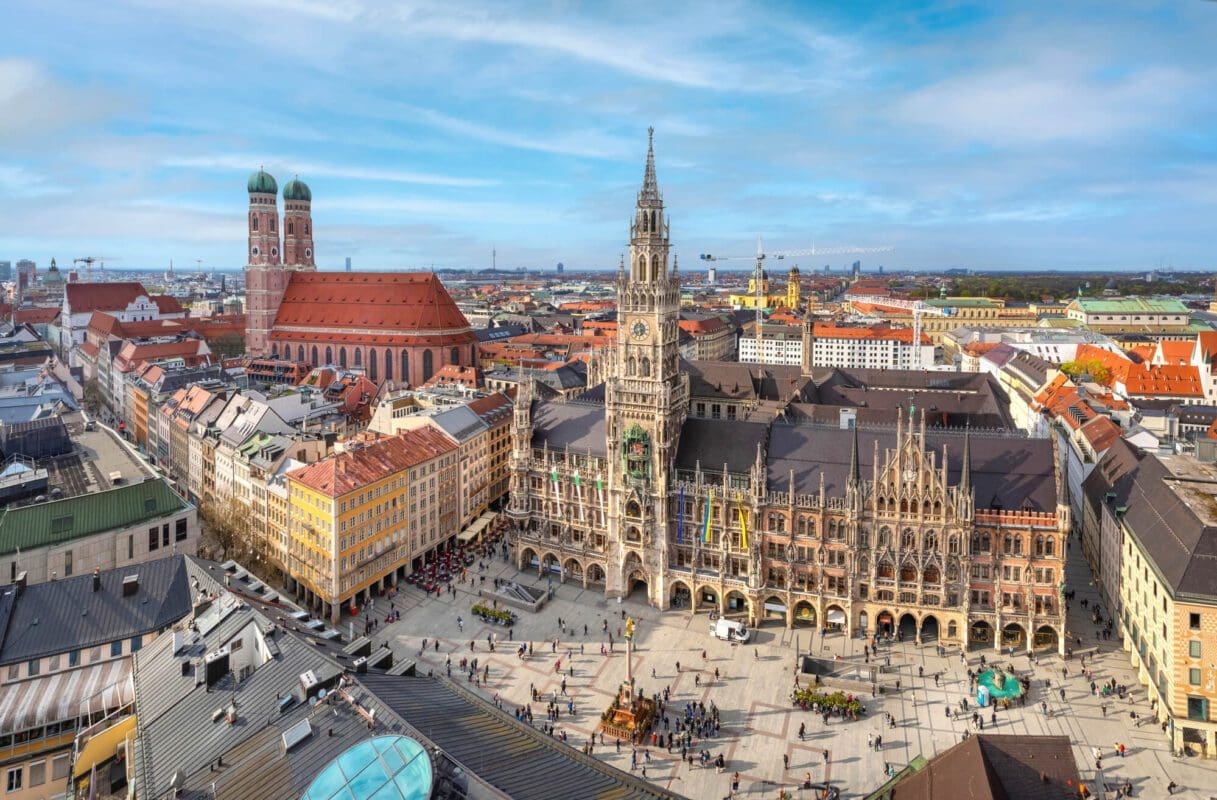
Another destination that is included in many German trip packages is Munich, the capital of Bavaria. This city is famous for its architectural beauty, cultural treasures, and the English Garden, a huge and delightful park that serves as the backyard of the city. Munich is also the site of the annual Oktoberfest celebration, attracting millions of tourists yearly to celebrate beer culture like nowhere else. When you are in Munich, be sure to check out the Altstadt, where you’ll find places like the Marienplatz and its splendid neo-gothic New Town Hall, as well as the nearby Frauenkirche and Viktualienmarkt, a must-see for foodies. Just outside the tourist center, you’ll discover the Nymphenburg Palace, where the beautiful architecture complements the delightful park setting. Moreover, Munich is also a getaway to the Bavarian Alps, which is the perfect place for hiking and skiing adventures. Also nearby is the Chiemsee, a picturesque lake known as the “Bavarian Sea,” surrounded by stunning alpine scenery
3. Neuschwanstein
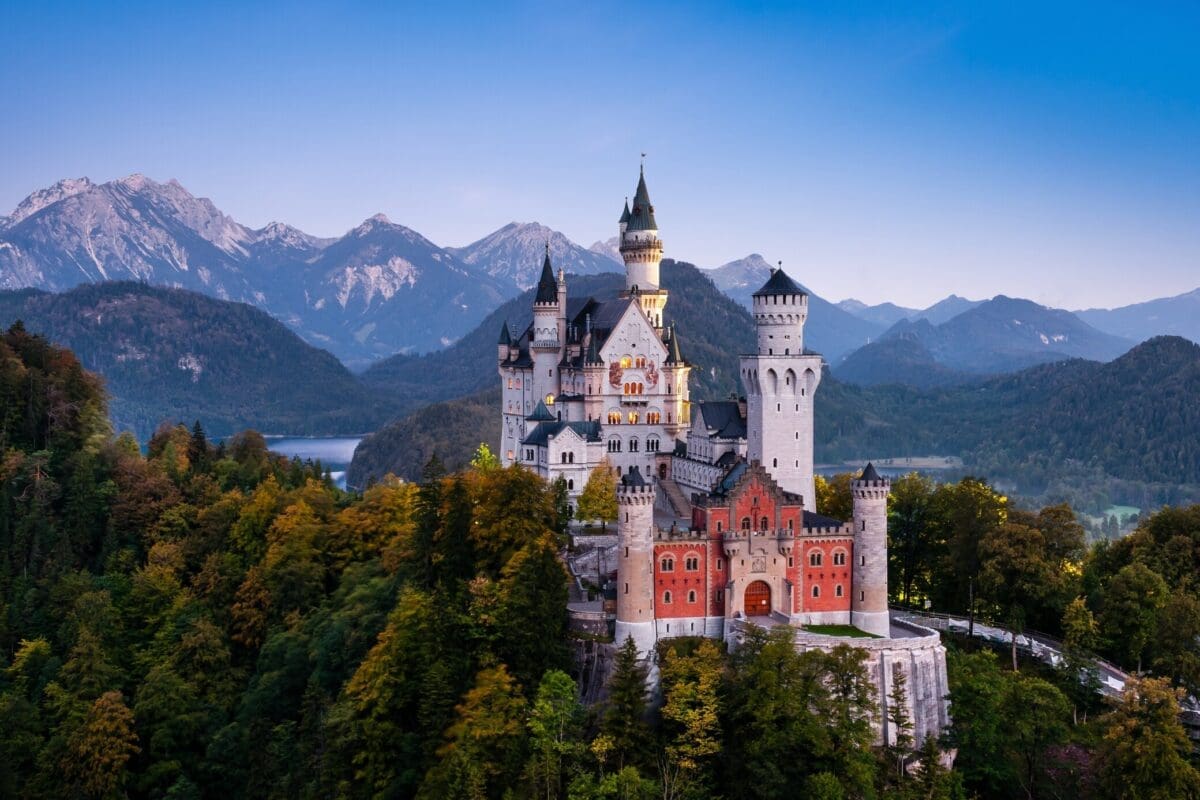
When planning a vacation to Germany, you can also plan a day excursion to Neuschwanstein Castle from Munich. Built by the “mad” King Ludwig II, it looks like a fairy-tale castle, which was just what Ludwig was going for. This castle is an architectural masterpiece and one of the must-visit places in Germany. You can explore the ornately decorated rooms, including the king’s bedroom, as well as the throne hall and stunning courtyards. Don’t forget to enjoy the breathtaking views of the surrounding mountains and the Alpsee Lake from the castle’s vantage points. You can reach the castle by taking a train from Munich to Fussen, which requires approximately 2 hours. From Fussen, you’ll need to take a bus ride to Hohenschwangau Village, where the castle is located. Want some more guidance? Our detailed itinerary directions in this Munich itinerary will make it easy.
4. Nuremberg
Nuremberg is a town of medieval architectural wonders. You can start your exploration by visiting Nuremberg’s Imperial Castle and enjoying the breathtaking views of the city. Make sure to stroll down to the Old Town, where you can explore the charming streets and scenic river canals. Make sure to visit the Albrecht-Durer-Haus, which is the former residence of the renowned artist Albrecht Durer. Nuremberg is famous not only for its historical sites and Christmas market, but also as a gateway to the Romantic Road, a picturesque route dotted with fairy-tale towns like Rothenburg ob der Tauber, Würzburg, and Bamberg (a UNESCO World Heritage Site). A visit means you can experience the authentic culture of Bavaria’s Franconia region. Finally, Nuremberg is also a good place to learn about a darker chapter in Germany’s history, as the former Nazi Rally Grounds and the courthouse where the Nuremberg Trials took place are both located within the city.
5. Dresden
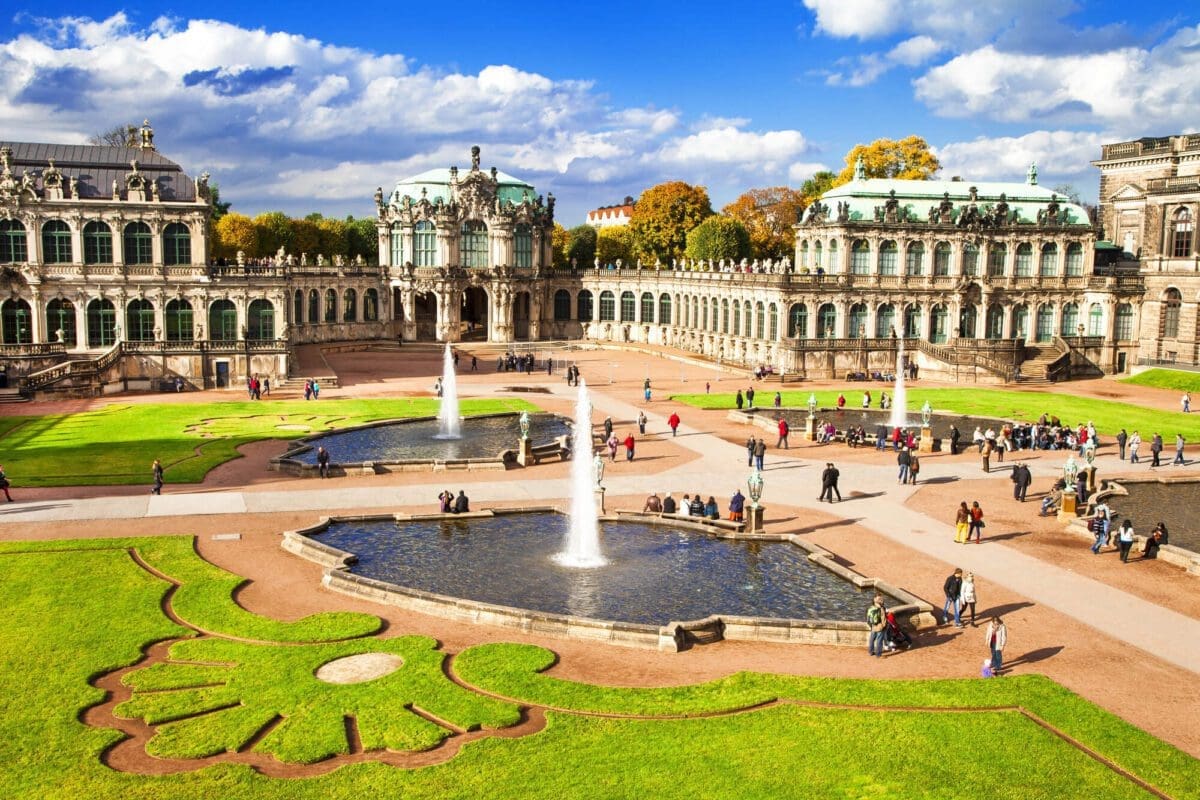
Another destination that you should include in your Germany trip planner is Dresden, which is famously referred to as “Florence on the Elbe”, due to its stunning architectural landmarks, vibrant art scene, and rich heritage. Here, you can walk across the Augustus Bridge, which offers scenic views of the city’s monumental architecture lining the Elbe River. Some other places not to miss in Dresden’s Old Town (Altstadt) include the Dresden Cathedral, Frauenkirche, and Neumarkt Square. To make the most of your visit to this beautiful German city and former capital of the Kingdom of Saxony, be sure to visit the Zwinger Palace and Gemäldegalerie Alte Meister, one of Europe’s greatest collections of art. Don’t forget to watch the stunning sunset from the Bruhl’s Terrace (Brühlsche Terrasse), known as the “Balcony of Europe,” offering panoramic city views.
6. Heidelberg
Heidelburg is nestled on the banks of the Neckar River, famous for its romantic charm and rich history. This quintessentially charming city is overlooked by the Heidelberg Castle, which looms above the Old Town on a hilltop shrouded by deep forest. In the Old Town (Altstadt) you’ll find cobblestone streets and charming shops, the historic Old Bridge (Alte Brücke), Heidelberg University (among the oldest and most prestigious universities in Europe), and much more. When you are here, you can also enjoy paddle boating in the Neckar River to get the full impact of the scenic setting. Cross the Old Bridge to enjoy a hike above Heidelberg on the Philosopher’s Way. You’ll be rewarded with magnificent views of the castle and Altstadt. You can also explore a bit further to discover the wonderful ruins of St. Michael’s church and the Thingstätte, a pseudo-Grecian amphitheater with a troubling history dating back to the Third Reich. Consider adding Heidelberg to your Germany trip packages for an unforgettable experience.
7. Hamburg
Hamburg, which is just 2 hours away from Berlin by fast train, is the second biggest city and the main port in Germany. Here, you can explore places like Hamburg Harbor (Hamburger Hafen), the International Maritime Museum, Mönckebergstrasse, and the Rathaus (City Hall). For history of a different type, take a boat tour through the Speicherstadt district, a UNESCO World Heritage Site of waterfront warehouses. The nearby Alster Lake is also a great spot to enjoy a boat ride. You can end your day here by visiting the Elbphilharmonie concert house, a modern architectural masterpiece, and a world-class concert hall. You can attend a concert or simply enjoy the breathtaking city views from the Plaza.
How to get around Germany
Traveling around Germany by train is an enriching and enjoyable experience, as you pass through scenic farmlands, forests, and a delightful range of topographies. For some travelers who are more used to car travel, using public transport and trains seems like a hurdle to overcome when planning a trip. Indeed, knowing the best modes of transport is essential to making the most of your journey. Germany boasts an efficient and extensive transportation network, making it quite easy to explore its vibrant cities, charming towns, and picturesque countryside without a private vehicle. If you feel that you need some help, Go Real Travel’s detailed itinerary directions and ticket purchases make the process easy.
Getting around Germany using public transport
When using public transportation in Germany’s cities, you will typically encounter two terms: U-Bahn and S-Bahn. The U-Bahn, short for Untergrundbahn or ‘underground railway,’ refers to conventional rapid transit systems, primarily underground subways. On the other hand, the S-Bahn, which stands for Stadtschnellbahn or ‘city rapid railway,’ refers to commuter rail services with metro-like characteristics. Trams and buses are also typically important components of the public transport systems in Germany. You can purchase tickets from the machines at the stops or from each city’s public transport app. If you are still a bit unsure about utilizing public transport, Go Real Travel itineraries provide detailed instructions on how to purchase tickets and navigate the systems.
Getting around Germany on a train

The best way to visit Germany is by train. The Deutsche Bahn (DB) operates a comprehensive and (mostly) punctual rail network that connects major cities and even many small villages. High-speed trains like the ICE (InterCity Express) can whisk you from Berlin to Munich in under four hours, offering comfort and convenience. After factoring in time at the airport, the train is usually much faster than flying, not to mention more pleasant. Regional trains, such as the RE (Regional Express), are perfect for shorter trips and exploring less touristy areas. Trains in Germany are known for their reliability, cleanliness, and efficiency, making them an excellent choice for travelers.
Purchasing tickets directly from Deutsche Bahn usually provides the best value. Unless you are traveling almost every day, EuroRail passes are typically not economical in comparison. Go Real Travel travel packages, such as this comprehensive Germany itinerary, also include pre-purchased tickets and ticket instructions, to make the whole journey easy and stress-free.
Getting around Germany in a car
For those who demand total flexibility and freedom, renting a car is another option. Germany’s autobahn system is world-famous, and driving can be a thrilling experience. But more often, it can be a surprisingly frustrating experience, as differences in driving laws and habits can be perplexing and dangerous for foreign drivers. Just as importantly, the no-speed-limit highways often turn into parking lots due to the infamous traffic jams that sometimes last for hours. If you feel that you are up for it though, car rentals allow you to explore at your own pace and reach destinations that are off the beaten path. However, remember that if your primary goal is to visit the big cities, renting a car is typically an extremely bad idea. Not only are many places out of reach for drivers, but public transport is often faster. And of course, parking in big cities can be very expensive and incredibly tricky. Americans should also keep in mind that fuel is more than twice as expensive as it is in the US.
Getting around Germany on bicycles
Germany is also very bicycle-friendly, with extensive bike lanes and rental options. Cities like Berlin, Munich, and Hamburg are particularly good for cycling, and a bicycle is often the fastest and most convenient way to get around these cities. Many rural areas also offer scenic bike routes, including many paved paths fully devoted to bikes. It’s a healthy and eco-friendly way to see the sights.
Must-see attractions in Germany
1. Berlin Wall
The Berlin Wall, a powerful symbol of the Cold War, divided East and West Berlin from 1961 to 1989. Today, its remnants are a poignant reminder of Germany’s turbulent history. The East Side Gallery, a section of the wall adorned with vibrant graffiti murals, offers a unique blend of art and history, making it one of the must-see attractions in Germany.
2. Heidelberg Castle
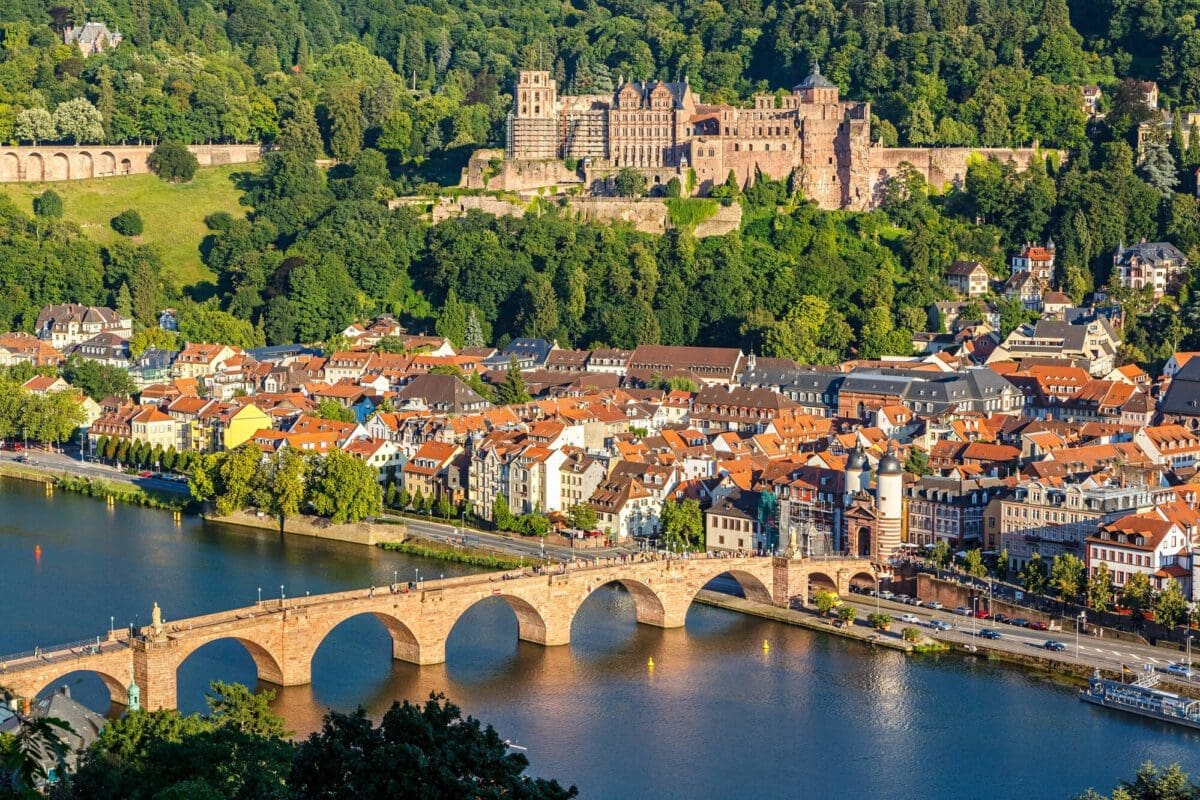
Perched majestically above the charming town of Heidelberg, Heidelberg Castle is an attractive blend of Gothic and Renaissance architecture. Its ruins, surrounded by lush greenery, tell tales of centuries past. You can explore the castle’s grand halls and ancient wine cellar and enjoy stunning views of the Neckar River and Old Town below.
3. Marienplatz in Munich

Marienplatz, the heart of Munich, is a bustling square known for its historic buildings and vibrant atmosphere. The New Town Hall dominates the square with its stunning Gothic architecture and famous Glockenspiel. You can watch the enchanting clockwork show, shop in nearby boutiques, or enjoy a meal at one of the many cafes lining the square.
4. Neuschwanstein Castle
Neuschwanstein Castle, nestled in the Bavarian Alps, looks like something out of a fairy tale. Built by King Ludwig II, this stunning 19th-century Romanesque & Gothic Revival palace inspired Walt Disney’s Sleeping Beauty Castle. With its turrets, towers, and breathtaking surroundings, Neuschwanstein offers an enchanting escape into a storybook world that you should not miss on your first trip to Germany.
5. Sanssouci Palace
Sanssouci Palace, located in Potsdam, was the summer retreat of Frederick the Great, King of Prussia. This elegant Rococo palace is surrounded by beautiful gardens and terraced vineyards, offering a glimpse into royal life. You can tour the lavishly decorated rooms, terraced vineyards, the Orangerie, and the Chinese Tea House and stroll through the expansive parklands, enjoying a serene and regal experience. It’s a short day trip from Berlin, and Go Real Travel itineraries such as this 11-day trip to Berlin, Prague, and Vienna, include detailed directions for making the journey.
6. Brandenburg Gate
The Brandenburg Gate, an iconic symbol of Berlin, stands proudly at the end of Unter den Linden Boulevard. This neoclassical monument, once a symbol of division in the Cold War, now represents German reunification and peace. Plan a trip to Germany to admire its grand architecture, learn about its historical significance, and enjoy the lively Pariser Platz surrounding it. A short walk from the gate you’ll also find the Holocaust Memorial, Reichstag building, and the vast Tiergarten public park.
7. Cologne Cathedral

Cologne Cathedral, a UNESCO World Heritage Site, is a masterpiece of Gothic architecture located in Cologne, Germany. Its twin spires dominate the city’s skyline, and its interior boasts stunning stained glass windows and intricate details. You can climb 533 steps to the top for panoramic views of Cologne, explore its vast nave, and marvel at the cathedral’s impressive craftsmanship. Boasting the largest facade of any medieval church, it somehow survived 14 direct hits during the WWII bombing, even as the city around it lay flattened.
How many days in Germany
To get even a taste of Germany, a minimum of five days is recommended, though a week would be better. This gives you enough time to explore one or two key cities like Berlin, Munich, and/or Cologne, soaking in their unique history and culture. If you have more time, a stay of 10 to 14 days lets you delve a little deeper into the country’s rich tapestry. If you want to get to know Germany, check out this epic 3-week tour of the country.
You can also combine your German adventure with visits to neighboring countries. Traveling to Prague in the Czech Republic, to Austria, and/or to Switzerland is easy due to Germany’s central location and excellent transportation links. These itineraries offer a blend of Germany’s vibrant cities, stunning castles, and picturesque countryside, and also include the diverse charms of its neighbors. Whether you’re exploring the fairytale Neuschwanstein Castle, cruising the Rhine River, or savoring Bavarian cuisine, Germany promises an unforgettable journey.
Top German Itineraries to choose from
Here are some of the top German Itineraries that you can choose from if you are traveling to Germany for the first time.
- 3-Week Epic All Around Germany Tour
- Charm of Paris and Germany in 10 Days
- A week in Berlin and Prague
- Ultimate Munich and Prague in 8 Days
- Best of East Germany and Prague in a week
Different types of Germany trip Packages/ Germany for everyone:
Germany is a destination for every type of traveler, offering a rich blend of experiences. History buffs can explore ancient castles and World War II landmarks. Nature lovers will enjoy the Black Forest, the Rhine River, and the Bavarian Alps. Urban adventurers can dive into the vibrant culture of cities like Berlin, Munich, and Hamburg. Foodies will delight in hearty German cuisine and world-class beer.
- Germany with family/kids—If you are planning a vacation to Germany with your kids, you can make the most of your trip by exploring places like the fairytale castle of Neuschwanstein, fun museums such as the Deutsche Museum in Munich, Berlin’s Tiergarten Zoo, Miniature Wonderland in Hamburg, and the amazing Tropical Islands Waterpark near Berlin. The last is a gigantic waterpark inside a former blimp hangar which even has its rain forest!
- Germany with your partner—Germany offers many romantic destinations for a perfect trip with your partner, such as Heidelberg, Rothenburg ob der Tauber, Bamberg, the Moselle Valley, Saxon Switzerland National Park, Lübeck, Freiburg, and many more. These places boast charming old-world architecture, picturesque landscapes, and cozy, intimate atmospheres that make for an enchanting and memorable getaway.
- Germany For Adventure—Germany is also great for a more active trip, including destinations like the Bavarian Alps, Black Forest, Saxon Switzerland National Park, Zugspitze, Eifel National Park, Spreewald, Berchtesgaden National Park, Harz Mountains, Lake Constance, and many other great spots for adventure lovers. These areas offer a wide range of outdoor activities such as hiking, skiing, cycling, and water sports, providing endless opportunities for thrill-seekers and nature enthusiasts alike.
- Germany for food: Munich and Nuremberg are two cities in Germany that are a paradise for food lovers looking for traditional German food. Some of the must-try foods and drinks are Schnitzel, Currywurst, Sauerkraut, Spätzle, Pretzels, Bratwurst, Apfelstrudel, and of course beer. For those seeking international cuisine and cutting-edge culinary experiences, Berlin and Frankfurt offer a diverse and innovative food scene that caters to a wide range of tastes.
Germany Travel Tips To Consider When Planning a vacation to Germany
Planning a trip to Germany? Here are some essential tips to ensure a smooth and enjoyable experience:
- Safety: Germany is generally safe, but like any other destination, be mindful of your belongings in crowded areas.
- Language: German is the official language, but English is widely spoken, especially in tourist areas. Learning a few basic phrases in German can be helpful and appreciated. The English word “hello” is similar to the German “hallo,” making it an easy option if you are not comfortable with more formal greetings like “Guten Tag” or “Grüß Gott.” This simple and friendly greeting is widely understood and accepted throughout Germany.
- Culture: Germans value punctuality and respect personal space. When meeting people, greet them with a handshake, and when entering restaurants and shops, it is considered polite to say hello to the shopkeeper or host. Also be aware of cultural norms, such as properly separating recyclables and not jaywalking.
- Booking Timing: Booking earlier is typically better, especially if traveling in the high season. The best hotels typically book up well in advance during the summer months and sometimes up to a year in advance during Oktoberfest in Munich:
- Start booking flights and accommodations at least 4-6 months in advance for the best rates.
- Book trips during the Christmas Market season by June/July to secure reasonable hotel rates.
- Book hotels for the Oktoberfest preferably at least 9 months or even earlier. It will be possible to book later, but the hotel selection will not be as good and prices will rise.
Let Go Real Travel Help You Plan
Planning a trip to Germany can be daunting, especially if it’s your first time. However, with Go Real Travel, you can sit back and relax while we handle all the details. From booking trains, tours, and accommodations, to creating a customized itinerary that covers iconic landmarks like the Brandenburg Gate and Neuschwanstein Castle, Go Real Travel ensures a hassle-free experience. Whether you’re drawn to Berlin’s vibrant culture or the scenic beauty of the Bavarian Alps, we tailor your journey to perfection. So let Go Real Travel plan a trip to Germany that’s seamless and unforgettable, so you can focus on enjoying rather than managing your trip.
Are you dreaming of Germany? Castles, incredible hiking, traditional beer halls, and charming medieval town squares await you! But planning a vacation to Germany for the first time can be a bit overwhelming and it can be difficult to know where to start. Don’t worry, we are here to help you! From the enchanting Bavarian Alps to vibrant cities like Berlin and Munich, Germany has 51 UNESCO World Heritage Sites to explore. Are you struggling to decide between historic castles or museums? Unsure about navigating through Germany, or what is the best time to visit? This guide is your go-to resource to plan a trip to Germany seamlessly. With this, you can turn your dream of exploring Germany into reality with ease and confidence.
When is the best time to visit Germany?
Now, when you are traveling to Germany for the first time, the first question that may arise in your mind is when is the best time to visit Germany? Below you’ll find detailed information on every season so that you can plan your trip accordingly:
Summer (June to August)

The summer season in Germany is the peak tourist season. The hot temperatures make it the perfect time to explore the country’s picturesque lakes and majestic mountains. People usually flock to the beer gardens or to the lakes to swim. Whether you are hiking in the Bavarian Alps or relaxing by Lake Chiemsee, there are countless reasons why summer is the best time to explore Germany. But if you are planning your summer German vacation, book your accommodation and transportation well in advance.
Shoulder Season (Late Spring or Early Autumn)
If you are looking for Goldilocks weather, not too hot, and not too cold, then you can consider the late spring months (May to June) and early autumn months (September to October). May and June have very long days, making it a perfect time for sightseeing as the daylight stretches late into the evening. If you want to experience the high Bavarian Alps, September to early October are less crowded than the summer months and most of the peaks are still free of snow, meaning it’s ideal for hiking. It is also a great time to explore sightseeing and Germany’s cultural treasures.
Munich during Oktoberfest
Are you thinking of visiting Munich during Oktoberfest? It’s an incredible start for a first trip to Germany, as you quaff beer in giant, festively-decorated tents, surrounded by locals dressed in traditional dirndls and lederhosen. But you must prepare well in advance. Oktoberfest, which runs from late September to early October, attracts lots of travelers to Munich. So, if you want to explore Munich and don’t want to attend Oktoberfest, then it’s advisable to avoid this period. If you do want to see this spectacle, you should book your accommodations and flight tickets 9+ months before.
Winter Season (Late November to February)

Winter in regions such as Bavaria and the Black Forest transforms landscapes into winter wonderlands, where the temperature sometimes drops as low as 15 degrees Fahrenheit (-10C). During November and December, Germany is famous for its holiday spirit and Christmas Markets which transform traditional town squares into enchanting winter wonderlands filled with twinkling lights, festive decorations, and a warm, inviting atmosphere perfect for celebrating the season. They occur all over the country, but some of the must-see markets include Munich, Nuremberg, and Dresden. Moreover, the ski resorts in the Alps and Black Forest attract winter sports enthusiasts to its snowy slopes. A final tip is to visit Rothenburg ob der Tauber, which is a small town on Bavaria’s Romantic Road. In the winter season, it looks like it came straight out of a holiday storybook and the whole town goes “all-out” on Christmas.
Which Destinations to Choose When Planning a Vacation to Germany
1. Berlin

The first destination you can choose when you are traveling to Germany for the first time is Berlin. Berlin is the capital and heart of modern Germany. The city is famous not only for its techno culture but also for being a melting pot of eras and empires perfect for history lovers. You can discover iconic landmarks like the Brandenburg Gate. Originally built to celebrate victory in war, it became a symbol of division during the Cold War and now represents unity and peace. Nearby you can walk up the glass dome of the Reichstag building, looking down at the lawmakers of the German parliament below, while enjoying epic views of the city around you. You can also visit the Berlin Wall and Checkpoint Charlie to learn more about Germany’s Cold War past. Next, go to Museum Island, a UNESCO World Heritage Site home to 5 world-class museums nestled amidst the River Spree.

Want to build your own trip to Berlin instead?
Instantly create your own customized trip with our easy to use trip builder
2. Munich

Another destination that is included in many German trip packages is Munich, the capital of Bavaria. This city is famous for its architectural beauty, cultural treasures, and the English Garden, a huge and delightful park that serves as the backyard of the city. Munich is also the site of the annual Oktoberfest celebration, attracting millions of tourists yearly to celebrate beer culture like nowhere else. When you are in Munich, be sure to check out the Altstadt, where you’ll find places like the Marienplatz and its splendid neo-gothic New Town Hall, as well as the nearby Frauenkirche and Viktualienmarkt, a must-see for foodies. Just outside the tourist center, you’ll discover the Nymphenburg Palace, where the beautiful architecture complements the delightful park setting. Moreover, Munich is also a getaway to the Bavarian Alps, which is the perfect place for hiking and skiing adventures. Also nearby is the Chiemsee, a picturesque lake known as the “Bavarian Sea,” surrounded by stunning alpine scenery
3. Neuschwanstein
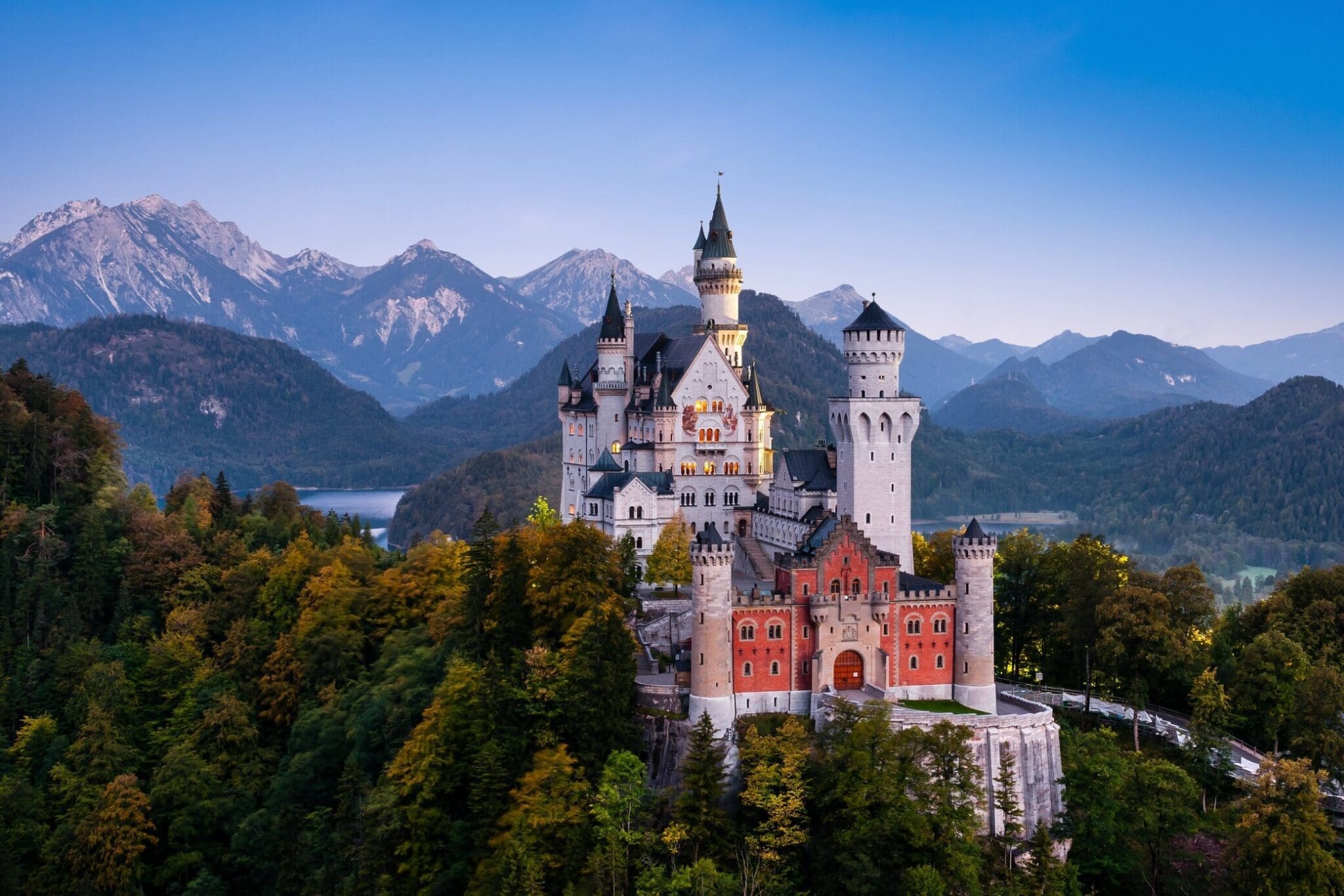
When planning a vacation to Germany, you can also plan a day excursion to Neuschwanstein Castle from Munich. Built by the “mad” King Ludwig II, it looks like a fairy-tale castle, which was just what Ludwig was going for. This castle is an architectural masterpiece and one of the must-visit places in Germany. You can explore the ornately decorated rooms, including the king’s bedroom, as well as the throne hall and stunning courtyards. Don’t forget to enjoy the breathtaking views of the surrounding mountains and the Alpsee Lake from the castle’s vantage points. You can reach the castle by taking a train from Munich to Fussen, which requires approximately 2 hours. From Fussen, you’ll need to take a bus ride to Hohenschwangau Village, where the castle is located. Want some more guidance? Our detailed itinerary directions in this Munich itinerary will make it easy.
4. Nuremberg
Nuremberg is a town of medieval architectural wonders. You can start your exploration by visiting Nuremberg’s Imperial Castle and enjoying the breathtaking views of the city. Make sure to stroll down to the Old Town, where you can explore the charming streets and scenic river canals. Make sure to visit the Albrecht-Durer-Haus, which is the former residence of the renowned artist Albrecht Durer. Nuremberg is famous not only for its historical sites and Christmas market, but also as a gateway to the Romantic Road, a picturesque route dotted with fairy-tale towns like Rothenburg ob der Tauber, Würzburg, and Bamberg (a UNESCO World Heritage Site). A visit means you can experience the authentic culture of Bavaria’s Franconia region. Finally, Nuremberg is also a good place to learn about a darker chapter in Germany’s history, as the former Nazi Rally Grounds and the courthouse where the Nuremberg Trials took place are both located within the city.
5. Dresden

Another destination that you should include in your Germany trip planner is Dresden, which is famously referred to as “Florence on the Elbe”, due to its stunning architectural landmarks, vibrant art scene, and rich heritage. Here, you can walk across the Augustus Bridge, which offers scenic views of the city’s monumental architecture lining the Elbe River. Some other places not to miss in Dresden’s Old Town (Altstadt) include the Dresden Cathedral, Frauenkirche, and Neumarkt Square. To make the most of your visit to this beautiful German city and former capital of the Kingdom of Saxony, be sure to visit the Zwinger Palace and Gemäldegalerie Alte Meister, one of Europe’s greatest collections of art. Don’t forget to watch the stunning sunset from the Bruhl’s Terrace (Brühlsche Terrasse), known as the “Balcony of Europe,” offering panoramic city views.
6. Heidelberg
Heidelburg is nestled on the banks of the Neckar River, famous for its romantic charm and rich history. This quintessentially charming city is overlooked by the Heidelberg Castle, which looms above the Old Town on a hilltop shrouded by deep forest. In the Old Town (Altstadt) you’ll find cobblestone streets and charming shops, the historic Old Bridge (Alte Brücke), Heidelberg University (among the oldest and most prestigious universities in Europe), and much more. When you are here, you can also enjoy paddle boating in the Neckar River to get the full impact of the scenic setting. Cross the Old Bridge to enjoy a hike above Heidelberg on the Philosopher’s Way. You’ll be rewarded with magnificent views of the castle and Altstadt. You can also explore a bit further to discover the wonderful ruins of St. Michael’s church and the Thingstätte, a pseudo-Grecian amphitheater with a troubling history dating back to the Third Reich. Consider adding Heidelberg to your Germany trip packages for an unforgettable experience.
7. Hamburg
Hamburg, which is just 2 hours away from Berlin by fast train, is the second biggest city and the main port in Germany. Here, you can explore places like Hamburg Harbor (Hamburger Hafen), the International Maritime Museum, Mönckebergstrasse, and the Rathaus (City Hall). For history of a different type, take a boat tour through the Speicherstadt district, a UNESCO World Heritage Site of waterfront warehouses. The nearby Alster Lake is also a great spot to enjoy a boat ride. You can end your day here by visiting the Elbphilharmonie concert house, a modern architectural masterpiece, and a world-class concert hall. You can attend a concert or simply enjoy the breathtaking city views from the Plaza.
How to get around Germany
Traveling around Germany by train is an enriching and enjoyable experience, as you pass through scenic farmlands, forests, and a delightful range of topographies. For some travelers who are more used to car travel, using public transport and trains seems like a hurdle to overcome when planning a trip. Indeed, knowing the best modes of transport is essential to making the most of your journey. Germany boasts an efficient and extensive transportation network, making it quite easy to explore its vibrant cities, charming towns, and picturesque countryside without a private vehicle. If you feel that you need some help, Go Real Travel’s detailed itinerary directions and ticket purchases make the process easy.
Getting around Germany using public transport
When using public transportation in Germany’s cities, you will typically encounter two terms: U-Bahn and S-Bahn. The U-Bahn, short for Untergrundbahn or ‘underground railway,’ refers to conventional rapid transit systems, primarily underground subways. On the other hand, the S-Bahn, which stands for Stadtschnellbahn or ‘city rapid railway,’ refers to commuter rail services with metro-like characteristics. Trams and buses are also typically important components of the public transport systems in Germany. You can purchase tickets from the machines at the stops or from each city’s public transport app. If you are still a bit unsure about utilizing public transport, Go Real Travel itineraries provide detailed instructions on how to purchase tickets and navigate the systems.
Getting around Germany on a train

The best way to visit Germany is by train. The Deutsche Bahn (DB) operates a comprehensive and (mostly) punctual rail network that connects major cities and even many small villages. High-speed trains like the ICE (InterCity Express) can whisk you from Berlin to Munich in under four hours, offering comfort and convenience. After factoring in time at the airport, the train is usually much faster than flying, not to mention more pleasant. Regional trains, such as the RE (Regional Express), are perfect for shorter trips and exploring less touristy areas. Trains in Germany are known for their reliability, cleanliness, and efficiency, making them an excellent choice for travelers.
Purchasing tickets directly from Deutsche Bahn usually provides the best value. Unless you are traveling almost every day, EuroRail passes are typically not economical in comparison. Go Real Travel travel packages, such as this comprehensive Germany itinerary, also include pre-purchased tickets and ticket instructions, to make the whole journey easy and stress-free.
Getting around Germany in a car
For those who demand total flexibility and freedom, renting a car is another option. Germany’s autobahn system is world-famous, and driving can be a thrilling experience. But more often, it can be a surprisingly frustrating experience, as differences in driving laws and habits can be perplexing and dangerous for foreign drivers. Just as importantly, the no-speed-limit highways often turn into parking lots due to the infamous traffic jams that sometimes last for hours. If you feel that you are up for it though, car rentals allow you to explore at your own pace and reach destinations that are off the beaten path. However, remember that if your primary goal is to visit the big cities, renting a car is typically an extremely bad idea. Not only are many places out of reach for drivers, but public transport is often faster. And of course, parking in big cities can be very expensive and incredibly tricky. Americans should also keep in mind that fuel is more than twice as expensive as it is in the US.

Want to build your own trip to Germany instead?
Instantly create your own customized trip with our easy to use trip builder
Getting around Germany on bicycles
Germany is also very bicycle-friendly, with extensive bike lanes and rental options. Cities like Berlin, Munich, and Hamburg are particularly good for cycling, and a bicycle is often the fastest and most convenient way to get around these cities. Many rural areas also offer scenic bike routes, including many paved paths fully devoted to bikes. It’s a healthy and eco-friendly way to see the sights.
Must-see attractions in Germany
1. Berlin Wall
The Berlin Wall, a powerful symbol of the Cold War, divided East and West Berlin from 1961 to 1989. Today, its remnants are a poignant reminder of Germany’s turbulent history. The East Side Gallery, a section of the wall adorned with vibrant graffiti murals, offers a unique blend of art and history, making it one of the must-see attractions in Germany.
2. Heidelberg Castle

Perched majestically above the charming town of Heidelberg, Heidelberg Castle is an attractive blend of Gothic and Renaissance architecture. Its ruins, surrounded by lush greenery, tell tales of centuries past. You can explore the castle’s grand halls and ancient wine cellar and enjoy stunning views of the Neckar River and Old Town below.
3. Marienplatz in Munich

Marienplatz, the heart of Munich, is a bustling square known for its historic buildings and vibrant atmosphere. The New Town Hall dominates the square with its stunning Gothic architecture and famous Glockenspiel. You can watch the enchanting clockwork show, shop in nearby boutiques, or enjoy a meal at one of the many cafes lining the square.
4. Neuschwanstein Castle
Neuschwanstein Castle, nestled in the Bavarian Alps, looks like something out of a fairy tale. Built by King Ludwig II, this stunning 19th-century Romanesque & Gothic Revival palace inspired Walt Disney’s Sleeping Beauty Castle. With its turrets, towers, and breathtaking surroundings, Neuschwanstein offers an enchanting escape into a storybook world that you should not miss on your first trip to Germany.
5. Sanssouci Palace
Sanssouci Palace, located in Potsdam, was the summer retreat of Frederick the Great, King of Prussia. This elegant Rococo palace is surrounded by beautiful gardens and terraced vineyards, offering a glimpse into royal life. You can tour the lavishly decorated rooms, terraced vineyards, the Orangerie, and the Chinese Tea House and stroll through the expansive parklands, enjoying a serene and regal experience. It’s a short day trip from Berlin, and Go Real Travel itineraries such as this 11-day trip to Berlin, Prague, and Vienna, include detailed directions for making the journey.
6. Brandenburg Gate
The Brandenburg Gate, an iconic symbol of Berlin, stands proudly at the end of Unter den Linden Boulevard. This neoclassical monument, once a symbol of division in the Cold War, now represents German reunification and peace. Plan a trip to Germany to admire its grand architecture, learn about its historical significance, and enjoy the lively Pariser Platz surrounding it. A short walk from the gate you’ll also find the Holocaust Memorial, Reichstag building, and the vast Tiergarten public park.
7. Cologne Cathedral

Cologne Cathedral, a UNESCO World Heritage Site, is a masterpiece of Gothic architecture located in Cologne, Germany. Its twin spires dominate the city’s skyline, and its interior boasts stunning stained glass windows and intricate details. You can climb 533 steps to the top for panoramic views of Cologne, explore its vast nave, and marvel at the cathedral’s impressive craftsmanship. Boasting the largest facade of any medieval church, it somehow survived 14 direct hits during the WWII bombing, even as the city around it lay flattened.
How many days in Germany
To get even a taste of Germany, a minimum of five days is recommended, though a week would be better. This gives you enough time to explore one or two key cities like Berlin, Munich, and/or Cologne, soaking in their unique history and culture. If you have more time, a stay of 10 to 14 days lets you delve a little deeper into the country’s rich tapestry. If you want to get to know Germany, check out this epic 3-week tour of the country.
You can also combine your German adventure with visits to neighboring countries. Traveling to Prague in the Czech Republic, to Austria, and/or to Switzerland is easy due to Germany’s central location and excellent transportation links. These itineraries offer a blend of Germany’s vibrant cities, stunning castles, and picturesque countryside, and also include the diverse charms of its neighbors. Whether you’re exploring the fairytale Neuschwanstein Castle, cruising the Rhine River, or savoring Bavarian cuisine, Germany promises an unforgettable journey.
Top German Itineraries to choose from
Here are some of the top German Itineraries that you can choose from if you are traveling to Germany for the first time.
- 3-Week Epic All Around Germany Tour
- Charm of Paris and Germany in 10 Days
- A week in Berlin and Prague
- Ultimate Munich and Prague in 8 Days
- Best of East Germany and Prague in a week
Different types of Germany trip Packages/ Germany for everyone:
Germany is a destination for every type of traveler, offering a rich blend of experiences. History buffs can explore ancient castles and World War II landmarks. Nature lovers will enjoy the Black Forest, the Rhine River, and the Bavarian Alps. Urban adventurers can dive into the vibrant culture of cities like Berlin, Munich, and Hamburg. Foodies will delight in hearty German cuisine and world-class beer.
- Germany with family/kids—If you are planning a vacation to Germany with your kids, you can make the most of your trip by exploring places like the fairytale castle of Neuschwanstein, fun museums such as the Deutsche Museum in Munich, Berlin’s Tiergarten Zoo, Miniature Wonderland in Hamburg, and the amazing Tropical Islands Waterpark near Berlin. The last is a gigantic waterpark inside a former blimp hangar which even has its rain forest!
- Germany with your partner—Germany offers many romantic destinations for a perfect trip with your partner, such as Heidelberg, Rothenburg ob der Tauber, Bamberg, the Moselle Valley, Saxon Switzerland National Park, Lübeck, Freiburg, and many more. These places boast charming old-world architecture, picturesque landscapes, and cozy, intimate atmospheres that make for an enchanting and memorable getaway.
- Germany For Adventure—Germany is also great for a more active trip, including destinations like the Bavarian Alps, Black Forest, Saxon Switzerland National Park, Zugspitze, Eifel National Park, Spreewald, Berchtesgaden National Park, Harz Mountains, Lake Constance, and many other great spots for adventure lovers. These areas offer a wide range of outdoor activities such as hiking, skiing, cycling, and water sports, providing endless opportunities for thrill-seekers and nature enthusiasts alike.
- Germany for food: Munich and Nuremberg are two cities in Germany that are a paradise for food lovers looking for traditional German food. Some of the must-try foods and drinks are Schnitzel, Currywurst, Sauerkraut, Spätzle, Pretzels, Bratwurst, Apfelstrudel, and of course beer. For those seeking international cuisine and cutting-edge culinary experiences, Berlin and Frankfurt offer a diverse and innovative food scene that caters to a wide range of tastes.
Germany Travel Tips To Consider When Planning a vacation to Germany
Planning a trip to Germany? Here are some essential tips to ensure a smooth and enjoyable experience:
- Safety: Germany is generally safe, but like any other destination, be mindful of your belongings in crowded areas.
- Language: German is the official language, but English is widely spoken, especially in tourist areas. Learning a few basic phrases in German can be helpful and appreciated. The English word “hello” is similar to the German “hallo,” making it an easy option if you are not comfortable with more formal greetings like “Guten Tag” or “Grüß Gott.” This simple and friendly greeting is widely understood and accepted throughout Germany.
- Culture: Germans value punctuality and respect personal space. When meeting people, greet them with a handshake, and when entering restaurants and shops, it is considered polite to say hello to the shopkeeper or host. Also be aware of cultural norms, such as properly separating recyclables and not jaywalking.
- Booking Timing: Booking earlier is typically better, especially if traveling in the high season. The best hotels typically book up well in advance during the summer months and sometimes up to a year in advance during Oktoberfest in Munich:
- Start booking flights and accommodations at least 4-6 months in advance for the best rates.
- Book trips during the Christmas Market season by June/July to secure reasonable hotel rates.
- Book hotels for the Oktoberfest preferably at least 9 months or even earlier. It will be possible to book later, but the hotel selection will not be as good and prices will rise.
Let Go Real Travel Help You Plan
Planning a trip to Germany can be daunting, especially if it’s your first time. However, with Go Real Travel, you can sit back and relax while we handle all the details. From booking trains, tours, and accommodations, to creating a customized itinerary that covers iconic landmarks like the Brandenburg Gate and Neuschwanstein Castle, Go Real Travel ensures a hassle-free experience. Whether you’re drawn to Berlin’s vibrant culture or the scenic beauty of the Bavarian Alps, we tailor your journey to perfection. So let Go Real Travel plan a trip to Germany that’s seamless and unforgettable, so you can focus on enjoying rather than managing your trip.


